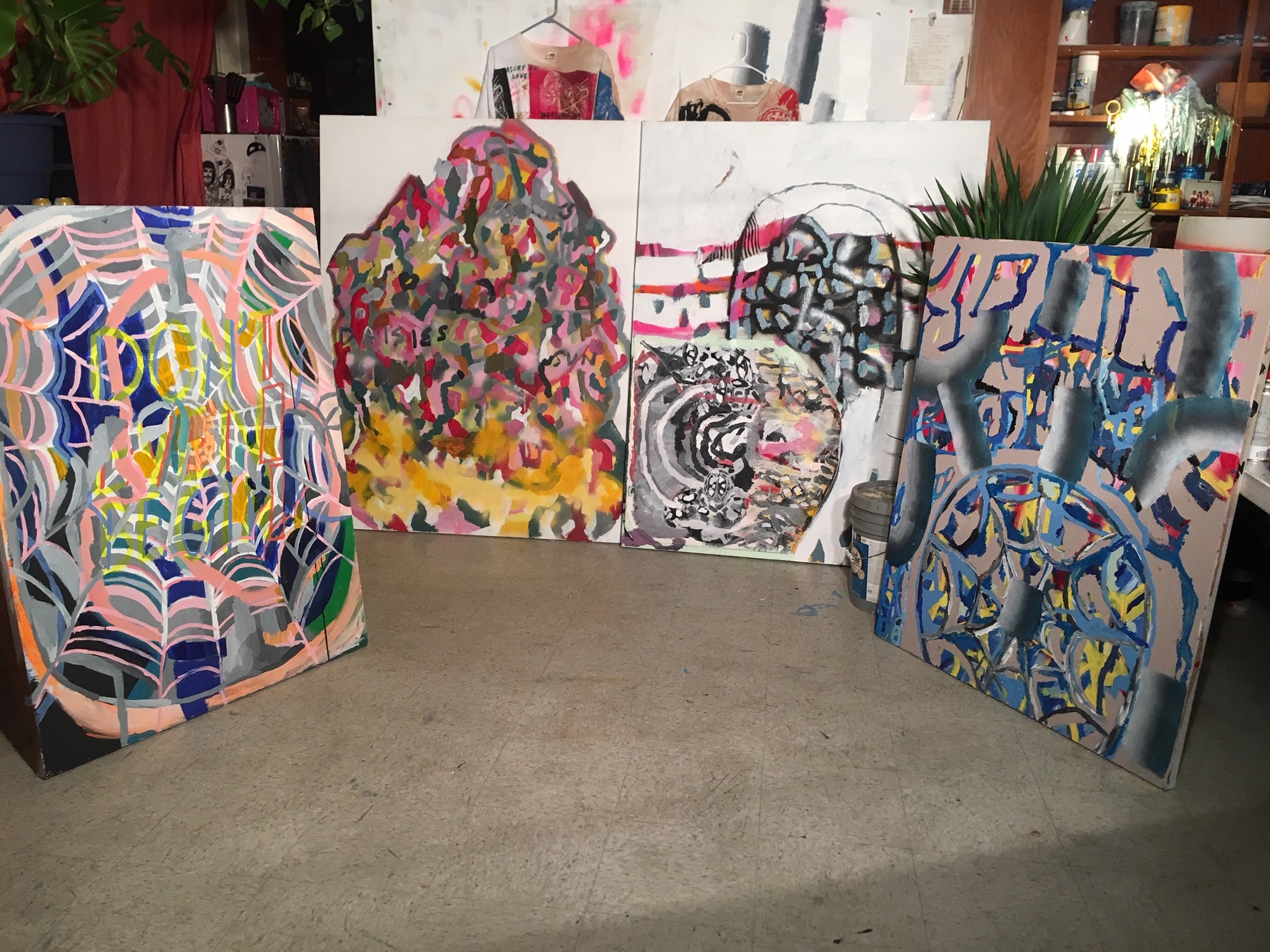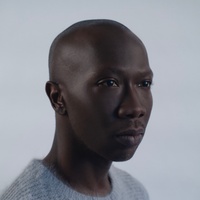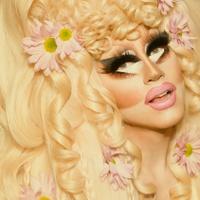On reassembling cultural narratives
Prelude
Based in Oakland and New Mexico but having spent most of her life moving between city centers, the Navajo Nation, and the Gila River Indian Community, Grace Rosario Perkins is interested in disassembling her personal narrative and reassembling it as one that layers words, objects, faces, and signifiers built from cultural dissonance, language, punk ethos, and history. Primarily a painter, Grace also works extensively in printed matter, textiles, writing, and sculpture.
Conversation
On reassembling cultural narratives
Artist and educator Grace Rosario Perkins on teaching students to view themselves as a source of discovery, incorporating Navajo culture and language into her work, and learning how to work bigger.
As told to Sara Wintz, 2836 words.
Tags: Art, Education, Inspiration, Process, Multi-tasking, Independence, Education.
What’s it like to be an art teacher?
I used to work for this project called Art in the Community. It was a good job, I liked it. But the inconsistency was really hard, and in general, the arts are super underfunded. I would build these really intense and wonderful relationships with the kids, and then I’d be like, “Well, bye! I’ll never see you again!” I always hated that part.
After I left that job, I moved to New Mexico and made a decision to focus on my art. Now I’m teaching at Mills. They asked me in the summer, and I was like, “Well, I could say no, but, on the flip side, if I’m not teaching, I’ll probably just be in my studio being weird so I might as well try teaching college students for the semester.”
I have this internal panic sometimes, where I’m like, “Am I doing a good job?” I’m teaching Painting Fundamentals. You’ve seen my work. Pretty much all the things they would want you to teach someone in a Painting 1 class, I don’t do. I don’t render or work from straightforward images. I was given a syllabus but I tweaked it and now it’s pretty experimental.
They’re doing Paul Thek’s questions from when he taught at Cooper Union. He had these questions for his 4D design class. They start out mundane, like, “What’s your name, what’s your age, what’s your religion, what are your parents’ religions, where were you born, where were they born?” Then they get a little bit more detailed, like, “What do you do to make yourself more physically attractive? Is attraction important? What is spirituality?”
All these different questions are prompts that essentially make the student look at themself as a source of discovery and investigation, which is pretty much my goal in this class, and maybe my goal period. They’re using these questions to create a final project that’s “a painted environment,” an installation-based piece that is working with one of the themes they’ve unearthed through these questions.
What are you working on today?
I have a solo show coming up in March at ONE Archives. ONE Archives is the largest (and I believe oldest) queer archive in the US and it’s housed at USC. This solo exhibition is in tandem with a box of Foucault’s writing they just got, from when he had an acid trip in Joshua Tree. Outside of that, it’s an exciting time because I’m also working on my second book but it’s going to be all writing, less art, and I’m planning the launch of a new art gallery in New Mexico.
How are you thinking through Foucault’s writing, as a painter?
Research is, to a certain extent, part of my practice… or rather I’m always just gathering information, maybe not necessarily for my work, but it’s something I do daily. I read things that inform the language that I use. A lot of my paintings use text as a guiding principle, or often there’s text that’s obscured or you can’t see the text at all. I like to think of hidden text as sets of intentions for a painting, or where I’m at in life, and that to me is a spellwork of sorts. It will most likely be something like that, but I’m not sure yet how it will be in the end. In the meantime, I’m working on a bunch of paintings, just to get into the groove of generating work.
I noticed that you’ve been thinking through language revitalization in your art practice. How does that thought-process manifest?
I haven’t done a painting that directly addresses this content, in a while. But what I’ve done throughout my, not even my practice, but throughout my experience, in this phase of my life, is: I’ll try and learn phrases and I’ll talk to my grandmother on the phone, and I’ll try and ask her about specific phrases, or I’ll try and really horribly sometimes, fumble completely through these phrases to her, without any sort of… I don’t try and lead it up like, “Oh, I’m going to speak to you [in Diné] now.” I just try and do it, and she’ll correct me. That’s become the process.
I did a performance once where I asked my grandma, “Well, how would you say this?” She would tell me, and then we would have phone sessions where she just trained me in the dialect, and I would repeat it back to her. We did that for a few weeks so that when I did the performance, I was confident in the pronunciation and I would videotape myself on the phone practicing with her on speaker phone.
She has become my language guide. At the same time, because she is a survivor of boarding schools and she’s in her mid 80s, her relationship to her language is really tense. Sometimes there are so many limitations. Navajo wasn’t a written language. She never learned how to read or write it. There are these things that we have to guess around.
It must be nice, as an elder, to have someone young coming to you, wanting to learn the language, as opposed to someone telling you not to speak in your language and devaluing it.
For sure. My grandma, all of my grandparents went to boarding school, that was the generation that was most impacted. After that, everyone was basically assimilated. As I’ve gotten older, I’ll say, “Hey Grandma. What’s up? Can we do this together?” She’s locking into my interest more. My grandma, for a long time, was like, “What does Grace do?” Saying “I’m an artist” is super abstract to indigenous people in their 80s. So, one day a couple years ago I walked her through my artist website which I wouldn’t do for anyone else, because it’s so boring and weird to be like, “Look at my website with me,” but I had to actually give her visuals and explain to her what I’m doing.
That was a really cool summer because I lived down the street from her. She came over every morning, we’d go for a short walk, then I would cook for her and we’d listen to Navajo radio. There’s a Navajo AM station KTNN and we would listen to it on the internet. I’d make her a pot of coffee and I got her to draw with me one day. She had never made art before.
During this period when she was living down the street from me and we had our own routine, there was a solar eclipse one day. I asked her, “How would you like to observe the solar eclipse?” There are traditions that are particular to the Diné and she said, “Yeah, we can do it that way.” We fasted and we sat inside with all of the curtains closed and we kind of just had silent reflection together for hours. At the end, she said this beautiful prayer.

Studio in Albuquerque NM, 2019
We’re pastoral people, so she raised sheep, and cows, and horses. She talked about herding sheep, and she talked about water, and those two things burned into my brain because it was really profound and honest as a closing sentiment. I made these paintings where those were the main texts embedded in the pieces, leaving only parts of the original phrases intact. Also, because I’m an abstract artist, when my grandma came to the show, she was happy, but then I asked her, “Oh, do you know those paintings are about you?” She was like, “They are?” I explained to her, “Do you remember that day, and what we did, and you said this?” She’s like, “Oh, yeah!” Then she got totally into it. I have pictures on my phone where she put her purse aside on the ground and was like, “Let me take a picture with this,” and she made everyone take pictures of her next to the paintings. It was super cute.
She’s the best. In a lot of ways, who I am now is an extension of these people. But I also have the privilege to be able to say, “I’m an artist.” When she worked with me on art, she told me that was the first painting she ever did. It’s really good. That was a couple years ago.
In all the work that you do: what feels valuable about being contemporary, or being tied to the contemporary moment?
I talk about that a lot. I’m always thinking about contemporary identity and representation. Sometimes, the way native people are perceived can be one-dimensional. I think a lot about indigenous work and identity. It’s one dimensional in that it’s like we’re seen as monolithic: one. They make these assumptions. I really hope that, though, in being contemporary, we can inhabit that space in a way that feels really open-ended.
Tradition’s important, too. I wrote something about that the other day. I was applying for a grant, and honestly, the grant is usually given to people who are going to uphold traditional work. When I was applying for it, I tried to explain where I’m at and how it can be used this way. I’m trying to open an art gallery and ideally the art gallery is going to also be a risograph press: the first of its kind in New Mexico. I wrote this long thing where I was like, “That’s so radical. Why can’t that be a tradition? Why can’t teaching a native apprentice how to use a risograph machine and how to do self-publishing be tradition?” To me, that’s completely revolutionizing. Self-publishing is one of the most important tools right now.
What’s the gallery going to be called? Do you know yet?
Yeah. I’m opening it with my partner, Greg Shimada, and it’s called Couples Therapy. It was kind of a joke, and we’re like, “No, we should actually call it that.” All of my friends who live in Albuquerque are like, “Wow, you’re really twisted.” I’m like, “Yeah, I know.”
The main idea behind having a risograph in the gallery is, we could have editions of every show we do so there’s something tangible and for sale. On top of that, it’s a resource for the community. Unity Press has their free print days here in Oakland. That would be amazing, to bring that to New Mexico and have people pay a really low drop-in fee. I’m talking $10, $20 dollars, and they’re able to print a project. That will sustain the price of inks or whatever we need to have the machine on site. That’s something that I really, really want to support. Then, every artist we show or exhibition that we have, we’ll do a poster or a zine or a book. Then, over time, there’s a rolling archive. At the end of our project, at the end of this eight-month period, we’re going to have a show of all the printed material together.
What’s your studio ritual like?
I have to clean, which is funny, because most people let their studio be messy. If my studio gets too out of control, I can’t focus. It takes me out of my making-space, and I get agitated. I have to straighten up a little bit before I clean. Then I usually burn sage and clear the space. I’ll open a window. I get in a zone. It’s funny, because the person I’m dating is also an artist, so I’ve been working with someone in my space at times. That’s new to me, but it’s also good because it’s a challenge finding out how to zone in, tune out in a shared space. But I’m usually alone. I like to be alone. I like to listen to music. I usually do 45 minutes of uninterrupted work. Then I’ll take a break. I want to say, “and then I clean up,” but I don’t. That’s why I really have to clean before I work, because I don’t clean up after I work. I’m incredibly messy.
What’s your favorite thing you’re working on right now?
A friend gave me some oil paints earlier this summer and I never really used oil before. I started working with oil, just dry brush painting, not using a lot of solvents or anything. I did a painting on a wood panel recently. I have been doing a lot of these web motifs lately, in my work.
Like spiderwebs?
Yeah. At this point I’ve done maybe seven or eight web paintings. Maybe one day I’ll show them all together. I did an oil painting of a web and it has a little headshot photo of my grandmother from her boarding school graduation. She looks really sweet. She has barrel-curled short hair and she’s smiling. I painted the words “Rose Madder” on the top, like the color. I was learning about rare pigments and rose madder is a pigment that’s often really expensive. It’s made from the roots of the madder plant. The color of it is really distinct, like a pink-rose. Oil paintings, it’s true, they’re wet forever. It became this precarious thing in my studio. I had to gently move it. The process of caring for it felt different.
Another thing that’s cool about teaching is that I’m learning a lot about myself in this process. I’m not teaching from a canon. I’m teaching from this very weird world of things that inform my work. It’s like, weird constellations. I did a slide lecture on the use of pattern for my students, and I showed them all these beautiful quilts by, I don’t know, Rosie Lee Tompkins, and I talked about webs. I showed them different kinds of webs and different kinds of weaving that happens in spiderwebs, depending on the breed of the spider. That’s where I’m at right now, a really heavy visual emphasis. I think it’s important to always look outside your medium for inspiration.
I’m remembering this moment in one of the interviews with you I read, where you were talking about being maximal. What does it mean to be maximal?
I have a mentor friend, the artist, Lonnie Holley. I love Lonnie. Lonnie and I met six years ago, and we’ve kept in touch for that many years. We talk on the phone. Sometimes we FaceTime. Sometimes he calls me, and a lot of times he tells me things I should make, and some of them are things where I’m like, “That’s kind of crazy. I probably won’t make that.” I used to take meticulous notes every time we talked and now I just put my energy into listening.
Overall, he said something to me, that as I move forward in my practice, I’m comfortable talking about now… He once talked to me about a large painting I did on an unstretched canvas. He was like, “I love that painting,” and he said, “I want you to make a bunch of them. Actually, I just want you to work really big always.” His response was, “I want you to get so big and overwhelming that you never have to feel submissive again.”
I think about that all the time. What does it mean to take up space like that? All the identities I inhabit, historically, are not completely welcomed by this world. That was such a beautiful, resonant kind of direction: “Yeah, just get really big. Never submit.” My whole practice since then, I’m always like, “bigger, bigger, bigger.” I still haven’t made something as big and whole as I want yet.
I don’t believe that you have to make big work for it to be good. But there is a specific challenge in working big. My way of inhabiting the studio may be different than someone who’s had a formal education. My restrictions are different. I don’t overthink. I know a lot of artists who use sketchbooks and transfer their drawings, or they plan their paintings. I don’t do that. I never sit down and map out painting. I’m very much just in my body. For me, that’s the maximal experience of it: navigating through this, working with as many colors as I can, working on three to four works at once. There’s almost confidence in the intuition.
Grace Rosario Perkins Recommends:
Five things:
Repeatedly listening to the same songs in the studio—this week I’m into Romeo Void’s “Myself to Myself,” Cathy Jean’s “Please Love Me Forever,” Pebbles “Girlfriend,” + DMX Krew “Come to Me”
Brown rice with chicken broth and butter as staple
Looking through deviantart accounts and/or etsy for bizarre cartoon variations, best art
Screenprinting, hand dyeing fabric, etc.
Hot springs, always
- Name
- Grace Rosario Perkins
- Vocation
- Artist, Gallerist, Educator
Some Things
Pagination



